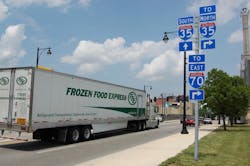Annual logistics report forecasts positive trends for trucking
Despite a forecast for still-tepid U.S. economic growth, freight volumes are expected to keep increasing this year with trucking capacity expected to continue tightening – a recipe that should result in freight rate hikes for the industry by as much as 5% to 8% before 2014 is over.
That’s but one of the predictions emanating from the 25th annual State of Logistics, unveiled at the National Press Club in Washington D.C. yesterday. Authored by Rosalyn Wilson, senior business analyst for Parsons, under the auspices of the Council of Supply Chain Management Professionals (CSCMP) and sponsored by Penske Logistics, the report’s main theme focused on the often contradictory paths indicated by past and current economic and freight patterns.[To view photos from the briefing event this week, please click here.]
“From a purely economic point of view, 2013 was a complicated year. It was not a stellar year for the economy, but freight did not always mirror the economy,” Wilson (seen at right) noted in her remarks.
“Freight volume in tonnage terms rose in 2013 more than the number of shipments and revenue figures suggest, but [freight] rates remained stubbornly flat,” she said. “That left the trucking industry, in particular, in a weaker position in 2013 [with] rising costs for drivers, equipment, and maintenance pushing marginal trucking companies over the edge, as the number of bankruptcies rose in 2013.”
Trucking – the largest component of transportation costs, according to Wilson’s research – posted a 1.6% rise in revenues in 2013, one of the weakest revenue years in the industry’s recent history. Intercity truck segment revenues rose 1.8% while revenues in the local delivery segment jumped 1.2%.
Overall, truck tonnage increased 6.1% in 2013, which is much higher than revenue figures would seem to indicate, and although the industry remains in Wilson’s words “at near 100% utilization” shippers still perceive that they have enough options to hold the line on rate increases – which is why rates to date have been relatively flat with the exception of spot rates when capacity is scarce.That will all change as 2014 progresses, as she said the industry’s capacity issue is becoming “more severe” as Federal Motor Carrier Safety Administration (FMCSA) hours of service (HOS) rule changes and other safety regulations take a bigger bite out of productivity.
Marc Althen (at center in photo at left), president of Penske Logistics and part of panel of industry experts assembled to discuss the report’s findings – noted those trucking productivity losses average about 3% across the industry, with losses higher in specific segments. For example, in the food & beverage delivery space, he said productivity losses due to federal regulations are running between 8% and 10%.
Parsons' Wilson pointed out that as trucking costs continue to rise – particularly to attract and retain existing drivers – the industry is experiencing a rising number of trucking failures. She referenced data collected by Donald Broughton of Avondale Partners who noted that by the end of 2013, trucking bankruptcies increased for seven consecutive quarters and were at a three-year high, with TL segment capacity reduced as a result by 2.5% in 2013 or some 21,775 trucks.
“The cost of attracting and retaining drivers has driven wages up, bringing them back in line with other industries,” noted Wilson. “This has lowered turnover rates, but they still remain high. Thus the trucking industry is facing a severe problem with demand increasing, while capacity is declining. The capacity loss is in real vehicles, as well as lowered productivity of current assets.”
She stressed that one way to help alleviate the ongoing shortage of commercial drivers is to lower the commercial driver’s license (CDL) age limit from 21 to 18 as a way to help capture young workers who forgo college.
“If they must wait for several years to get a CDL after graduating high school, they will enter another trade and pass trucking by,” Wilson said.
Despite those issues, the tightening capacity situation now offers better opportunity for motor carriers to raise rates compared with 2013, and as a result she expects rates to increase “significantly” by the end of 2014, probably into the 5% to 8% range.
Wilson also noted that one ripple effect from the trucking capacity shortage is a spike in demand for domestic third party logistics (3PL) services – a welcome development for that sector of the transportation industry.
“The [logistics] industry has been faced with slow growth globally, coupled with a general reticence to make new investments or change situations in the near future. The exception has been the continued strength of the domestic 3PL market,” she explained.
“Shippers are engaging 3PLs to ensure that they have the capacity when it is needed. While still the smallest segment, the domestic transportation management segment has been the fastest growing with gross revenues up 7.1% in 2013, just a little lower 2012’s 9.2%,” Wilson pointed out. “With capacity an issue, the dedicated contract carriage segment continues to gain, rising 3.6% in 2013.”Shippers on the logistics report’s panel echoed that view. “We are seeing freight get delayed now where it used to be reliable in terms of delivery times,” said Richard Jackson (second from left in photo at right), executive VP with Mast Global Logistics, an arm of the Limited Brands retail conglomerate.
“We’re now making a conscious decision to move to more dedicated fleet options and to position inventory where we can much closer to our stores,” he added.
The near-term situation is more broadly illustrated by Shippers Conditions Index (SCI) metric compiled by research for FTR Transportation Intelligence. While FTR’s SCI increased pulled back a point to negative of 7.7 for April, this one month change does not signal any real improvement in trucking capacity, which remains extremely tight, stressed Eric Starks, FTR’s President.
“The index remains in low territory reflecting the 98%-99% readings for truck capacity utilization, with little relief in sight until the next recession,” he said in a separate statement. “Freight growth should remain strong through the balance of the year and the rate shippers pay for truck freight will continue to rise.”
Starks also noted that while the shipping situation is not as critical as it was just a few months ago, when weather related issues disrupted the supply chain the industry remains near a tipping point.
“If the economy starts to accelerate as we move through the summer months, additional strain would be put on an already fragile capacity situation,” he warned. “Shippers should expect carriers to push rates higher as we move through the year. The biggest pressure will come from trucking companies who continue to struggle finding qualified drivers to move freight.”Parsons' Wilson thinks such a rosy scenario is in the making and based on her research expects 2014 to be a “banner year.”
“The first five months of 2014 has been the strongest since the end of the Great Recession [which] seems counter to the dismal 1% drop in GDP [gross domestic product] for the first quarter that showed a contraction in the economy,” she said.
Much of that decrease can be attributed to declining inventories, slowing exports, and weather-related issues, she explained, with numerous other economic signs – especially the American Trucking Associations (ATA) reporting a 1% jump in its for-hire truck tonnage index for May, following a revised 0.9% gain in April, with freight shipments up 13.1% overall since the beginning of the year, according to Wilson's data.
“I believe that 2014 will be a banner year,” Wilson stressed. “The performance of the overall economy overall has not been stellar in 2014, but freight continues to gain momentum and accelerate in the second quarter.”
“It isn’t just heavy freight for sectors like tank truck and flatbed from energy and housing that are improving this year. Now, generic dry van trailer freight is doing better as well, which wasn’t the case in 2013,” added ATA Chief Economist Bob Costello in a separate statement concerning the group’s monthly tonnage report. “This is a good sign for the economy.”
“The health of the freight market is a solid indicator of the direction the economy is moving,” Parsons' Wilson concluded. “All indications are that freight will grow moderately for the rest of the year and the economy should follow suit.”
About the Author
Sean Kilcarr
Editor in Chief
Sean Kilcarr is a former longtime FleetOwner senior editor who wrote for the publication from 2000 to 2018. He served as editor-in-chief from 2017 to 2018.




